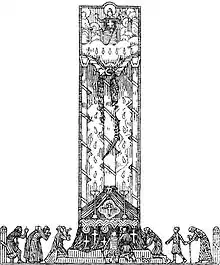Passio Olavi
Passio Olavi, more correctly Passio a miracule beati Olavi (The Passion and miracles of the Blessed Olaf) is a collection of legends about the Norwegian national saint Olaf II the Holy. The text was probably collected while Eysteinn Erlendsson was Archbishop of Nidaros (1159-1188), and is possibly written by Eysteinn himself. Egil Kraggerud dated the Passio Olavi to ca. 1150–1160.[1]

The text is available in two versions, the more familiar long version is an Old Norse version of an Old Norwegian Homily Book, read on St Olaf's feast day (Olsok).[2] A shorter version in Latin had wide distribution and is found in several places in Europe including : England, France, Austria and Finland.[2] The long version is also known in an English manuscript from Fountains Abbey near York, which was the parent monastery of Lyse Abbey in Norway.[2]
Editions
- Metcalfe, Frederick, ed. (1881). Passio et miracula beati Olaui: edited from a twelfth-century manuscript in the Library of Corpus Christi College, Oxford. Oxford: Clarendon Press.
- Phelpstead, Carl (comm.); Kunin, Devra (tr.) (2001). A history of Norway, and the passion and miracles of blessed Óláfr (PDF). Viking Society for Northern Research. ISBN 0903521482.
- Skard, Eiliv (tr.), ed. (1930). Passio Olavi; lidingssoga og undergjerningane åt den heilage Olav (in Norwegian). Carsten Lien (binding). Oslo: Samlaget.
- 2nd ed., Det Norske samlaget, 1970
- Facsimile edition. (with foreword by Arne Bakken). Det Norske samlaget, 1995. ISBN 82-521-4397-0
- Storm, Gustav, ed. (1880). "Acta sancti Olavi regis et martyris". Monumenta historica Norvegiæ. Trykt hos A.W. Brøgger. pp. 125–44. - shorter version
References
- Egil Kraggerud. "Hellig-Olavs dåp hos Theoricus Monachus og i hans kilder". In: Collegium Mediviale, 2012, P. 107.
- Gro Steinsland i innledningen til teksten i antologien Draumkvedet, og tekster fra norrøn middelalder, 2004.